Output Feedback Robust Tracking Control for a Variable-Speed Pump-Controlled Hydraulic System Subject to Mismatched Uncertainties
Abstract
1. Introduction
- For the first time, two ESOs were sophisticatedly coordinated to address the shortage of system state measurement mechanisms and the estimation of both matched and mismatched uncertainties in the studied pump-controlled hydraulic system. This combination serves as the basis for the implementation of the robust control algorithm, which merely requires the system output information.
- Based on the nominal system parameters and information provided by the above ESOs, a novel output feedback robust control mechanism in which the uncertainties and disturbances estimated by the ESOs are feedforward compensated was constructed to guarantee a high-accuracy motion control performance in spite of the nonlinearities and uncertainties in the system dynamics.
- The theoretical stability of the ESOs and overall closed-loop system was rigorously confirmed using Lyapunov’s theory. Several comparative experiment results are given to verify the effectiveness and superiority of the proposed control methodology over the existing popular control algorithms under different working conditions.
2. System Modeling and Problem Formulation
3. Control System Design
3.1. Extended State Observer Design
3.2. Mismatched Disturbance Observer
3.3. Observer-Based Control Strategy Design
4. Experiment Verification
4.1. Experiment Setup
- (a)
- (b)
- SESO-OFRBC: The output feedback control using a single ESO, which has similar structure to the proposed method. The parameters of the controller were also selected the same as the above controller with the observer bandwidth .
- (c)
- VF-PID: The proportional–integral controller with the velocity feedforward mechanism is mathematically presented aswhere and is the first derivative of the desired trajectory. As far we know, the PID is the most-popular control algorithm that is adopted in industrial applications due to the simple implementation and limited tuning parameters. In particular, it does not require the system model, and only the position of the actuator is required; hence, it can be treated as the reference controller for comparison. The parameters of the VF-PID controller were meticulously manually tuned to achieve an acceptable tracking performance and guarantee the system stability as , , , and . The selection of bigger parameters would cause the closed-loop system to be unstable.
- (i)
- The maximal absolute value of the tracking errors is given by
- (ii)
- The standard deviation performance index is defined aswhere denotes the average tracking error, which is calculated as .
4.2. Experimental Results
4.2.1. Case Study 1
4.2.2. Case Study 2
5. Conclusions
Author Contributions
Funding
Data Availability Statement
Conflicts of Interest
Abbreviations
| ADRC | Active disturbance rejection control |
| BC | Backstepping control |
| DSC | Dynamic surface control |
| EHS | Electro-hydraulic system |
| ESO | Extended state observer |
| HRA | Hydraulic rotary actuator |
| PID | Proportional–integral–derivative |
| SMC | Sliding mode control |
| SMO | Sliding mode observer |
| VSPHS | Variable-speed pump-controlled hydraulic system |
References
- Nguyen, M.H.; Ahn, K.K. A Novel Trajectory Adjustment Mechanism-Based Prescribed Performance Tracking Control for Electro-Hydraulic Systems Subject to Disturbances and Modeling Uncertainties. Appl. Sci. 2022, 12, 6034. [Google Scholar] [CrossRef]
- Nguyen, M.H.; Dao, H.V.; Ahn, K.K. Active Disturbance Rejection Control for Position Tracking of Electro-Hydraulic Servo Systems under Modeling Uncertainty and External Load. Actuators 2021, 10, 20. [Google Scholar] [CrossRef]
- Nguyen, M.H.; Dao, H.V.; Ahn, K.K. Extended sliding mode observer-based high-accuracy motion control for uncertain electro-hydraulic systems. Int. J. Robust Nonlinear Control 2023, 33, 1351–1370. [Google Scholar] [CrossRef]
- Li, C.; Lyu, L.; Helian, B.; Chen, Z.; Yao, B. Precision Motion Control of an Independent Metering Hydraulic System With Nonlinear Flow Modeling and Compensation. IEEE Trans. Ind. Electron. 2022, 69, 7088–7098. [Google Scholar] [CrossRef]
- Helian, B.; Chen, Z.; Yao, B.; Lyu, L.; Li, C. Accurate Motion Control of a Direct-Drive Hydraulic System With an Adaptive Nonlinear Pump Flow Compensation. IEEE/ASME Trans. Mechatron. 2021, 26, 2593–2603. [Google Scholar] [CrossRef]
- Sun, M.; Ouyang, X.; Mattila, J.; Chen, Z.; Yang, H.; Liu, H. Lightweight Electrohydrostatic Actuator Drive Solution for Exoskeleton Robots. IEEE/ASME Trans. Mechatron. 2022, 27, 4631–4642. [Google Scholar] [CrossRef]
- Truong, D.Q.; Ahn, K.K. Force control for hydraulic load simulator using self-tuning grey predictor—Fuzzy PID. Mechatronics 2009, 19, 233–246. [Google Scholar] [CrossRef]
- Do, T.C.; Tran, D.T.; Dinh, T.Q.; Ahn, K.K. Tracking Control for an Electro-Hydraulic Rotary Actuator Using Fractional Order Fuzzy PID Controller. Electronics 2020, 9, 926. [Google Scholar] [CrossRef]
- Feng, H.; Ma, W.; Yin, C.; Cao, D. Trajectory control of electro-hydraulic position servo system using improved PSO-PID controller. Autom. Constr. 2021, 127, 103722. [Google Scholar] [CrossRef]
- Fan, Y.; Shao, J.; Sun, G. Optimized PID Controller Based on Beetle Antennae Search Algorithm for Electro-Hydraulic Position Servo Control System. Sensors 2019, 19, 2727. [Google Scholar] [CrossRef]
- Cao, F. PID controller optimized by genetic algorithm for direct-drive servo system. Neural Comput. Appl. 2020, 32, 23–30. [Google Scholar] [CrossRef]
- Ma, W.; Ma, S.; Qiao, W.; Cao, D.; Yin, C. Research on PID Controller of Excavator Electro-Hydraulic System Based on Improved Differential Evolution. Machines 2023, 11, 143. [Google Scholar] [CrossRef]
- Chen, G.; Jia, P.; Yan, G.; Liu, H.; Chen, W.; Jia, C.; Ai, C. Research on Feedback-Linearized Sliding Mode Control of Direct-Drive Volume Control Electro-Hydraulic Servo System. Processes 2021, 9, 1676. [Google Scholar] [CrossRef]
- Alsaadi, F.E.; Yasami, A.; Alsubaie, H.; Alotaibi, A.; Jahanshahi, H. Control of a Hydraulic Generator Regulating System Using Chebyshev-Neural-Network-Based Non-Singular Fast Terminal Sliding Mode Method. Mathematics 2023, 11, 168. [Google Scholar] [CrossRef]
- Guo, Q.; Zhang, Y.; Celler, B.G.; Su, S.W. Backstepping Control of Electro-Hydraulic System Based on Extended-State-Observer With Plant Dynamics Largely Unknown. IEEE Trans. Ind. Electron. 2016, 63, 6909–6920. [Google Scholar] [CrossRef]
- Deng, W.; Yao, J.; Wang, Y.; Yang, X.; Chen, J. Output feedback backstepping control of hydraulic actuators with valve dynamics compensation. Mech. Syst. Signal Process. 2021, 158, 107769. [Google Scholar] [CrossRef]
- Ahn, K.K.; Nam, D.N.C.; Jin, M. Adaptive Backstepping Control of an Electrohydraulic Actuator. IEEE/ASME Trans. Mechatron. 2014, 19, 987–995. [Google Scholar] [CrossRef]
- Guo, Q.; Chen, Z.; Shi, Y.; Li, X.; Yan, Y.; Guo, F.; Li, S. Synchronous control for multiple electrohydraulic actuators with feedback linearization. Mech. Syst. Signal Process. 2022, 178, 109280. [Google Scholar] [CrossRef]
- Helian, B.; Chen, Z.; Yao, B. Constrained Motion Control of an Electro-hydraulic Actuator under Multiple Time-varying Constraints. IEEE Trans. Ind. Inform. 2023, 1–11. [Google Scholar] [CrossRef]
- Tran, D.-T.; Do, T.-C.; Ahn, K.-K. Extended High Gain Observer-Based Sliding Mode Control for an Electro-hydraulic System with a Variant Payload. Int. J. Precis. Eng. Manuf. 2019, 20, 2089–2100. [Google Scholar] [CrossRef]
- Tri, N.M.; Ba, D.X.; Ahn, K.K. A Gain-Adaptive Intelligent Nonlinear Control for an Electrohydraulic Rotary Actuator. Int. J. Precis. Eng. Manuf. 2018, 19, 665–673. [Google Scholar] [CrossRef]
- Swaroop, D.; Hedrick, J.K.; Yip, P.P.; Gerdes, J.C. Dynamic surface control for a class of nonlinear systems. IEEE Trans. Autom. Control 2000, 45, 1893–1899. [Google Scholar] [CrossRef]
- Luenberger, D. An introduction to observers. IEEE Trans. Autom. Control 1971, 16, 596–602. [Google Scholar] [CrossRef]
- Zeitz, M. The extended Luenberger observer for nonlinear systems. Syst. Control Lett. 1987, 9, 149–156. [Google Scholar] [CrossRef]
- Spurgeon, S.K. Sliding mode observers: A survey. Int. J. Syst. Sci. 2008, 39, 751–764. [Google Scholar] [CrossRef]
- Palli, G.; Strano, S.; Terzo, M. A novel adaptive-gain technique for high-order sliding-mode observers with application to electro-hydraulic systems. Mech. Syst. Signal Process. 2020, 144, 106875. [Google Scholar] [CrossRef]
- Li, S.; Guo, Q.; Yan, Y.; Shi, Y. Terminal sliding mode observer based–asymptotic tracking control of electro-hydraulic systems with lumped uncertainties. Trans. Inst. Meas. Control 2022, 45, 17–26. [Google Scholar] [CrossRef]
- McCann, R.A.; Islam, M.S.; Husain, I. Application of a sliding-mode observer for position and speed estimation in switched reluctance motor drives. IEEE Trans. Ind. Appl. 2001, 37, 51–58. [Google Scholar] [CrossRef]
- Xu, W.; Qu, S.; Zhao, L.; Zhang, H. An Improved Adaptive Sliding Mode Observer for Middle- and High-Speed Rotor Tracking. IEEE Trans. Power Electron. 2021, 36, 1043–1053. [Google Scholar] [CrossRef]
- Rahnavard, M.; Ayati, M.; Yazdi, M.R.H. Robust actuator and sensor fault reconstruction of wind turbine using modified sliding mode observer. Trans. Inst. Meas. Control 2018, 41, 1504–1518. [Google Scholar] [CrossRef]
- Habibi, H.; Howard, I.; Simani, S.; Fekih, A. Decoupling Adaptive Sliding Mode Observer Design for Wind Turbines Subject to Simultaneous Faults in Sensors and Actuators. IEEE/CAA J. Autom. Sin. 2021, 8, 837–847. [Google Scholar] [CrossRef]
- Han, J. From PID to Active Disturbance Rejection Control. IEEE Trans. Ind. Electron. 2009, 56, 900–906. [Google Scholar] [CrossRef]
- Xu, Z.; Deng, W.; Shen, H.; Yao, J. Extended-State-Observer-Based Adaptive Prescribed Performance Control for Hydraulic Systems With Full-State Constraints. IEEE/ASME Trans. Mechatron. 2022, 27, 5615–5625. [Google Scholar] [CrossRef]
- Chen, Z.; Guo, Q.; Li, T.; Yan, Y.; Jiang, D. Gait Prediction and Variable Admittance Control for Lower Limb Exoskeleton With Measurement Delay and Extended-State-Observer. IEEE Trans. Neural Netw. Learn. Syst. 2022, 1–14. [Google Scholar] [CrossRef]
- Wang, J.; Huang, D.; Fang, S.; Wang, Y.; Xu, W. Model Predictive Control for ARC Motors Using Extended State Observer and Iterative Learning Methods. IEEE Trans. Energy Convers. 2022, 37, 2217–2226. [Google Scholar] [CrossRef]
- Yue, J.; Liu, L.; Peng, Z.; Wang, D.; Li, T. Data-driven adaptive extended state observer design for autonomous surface vehicles with unknown input gains based on concurrent learning. Neurocomputing 2022, 467, 337–347. [Google Scholar] [CrossRef]
- Sun, L.; Li, G.; You, F. Combined internal resistance and state-of-charge estimation of lithium-ion battery based on extended state observer. Renew. Sustain. Energy Rev. 2020, 131, 109994. [Google Scholar] [CrossRef]
- Yao, J.; Jiao, Z.; Ma, D. Extended-State-Observer-Based Output Feedback Nonlinear Robust Control of Hydraulic Systems With Backstepping. IEEE Trans. Ind. Electron. 2014, 61, 6285–6293. [Google Scholar] [CrossRef]
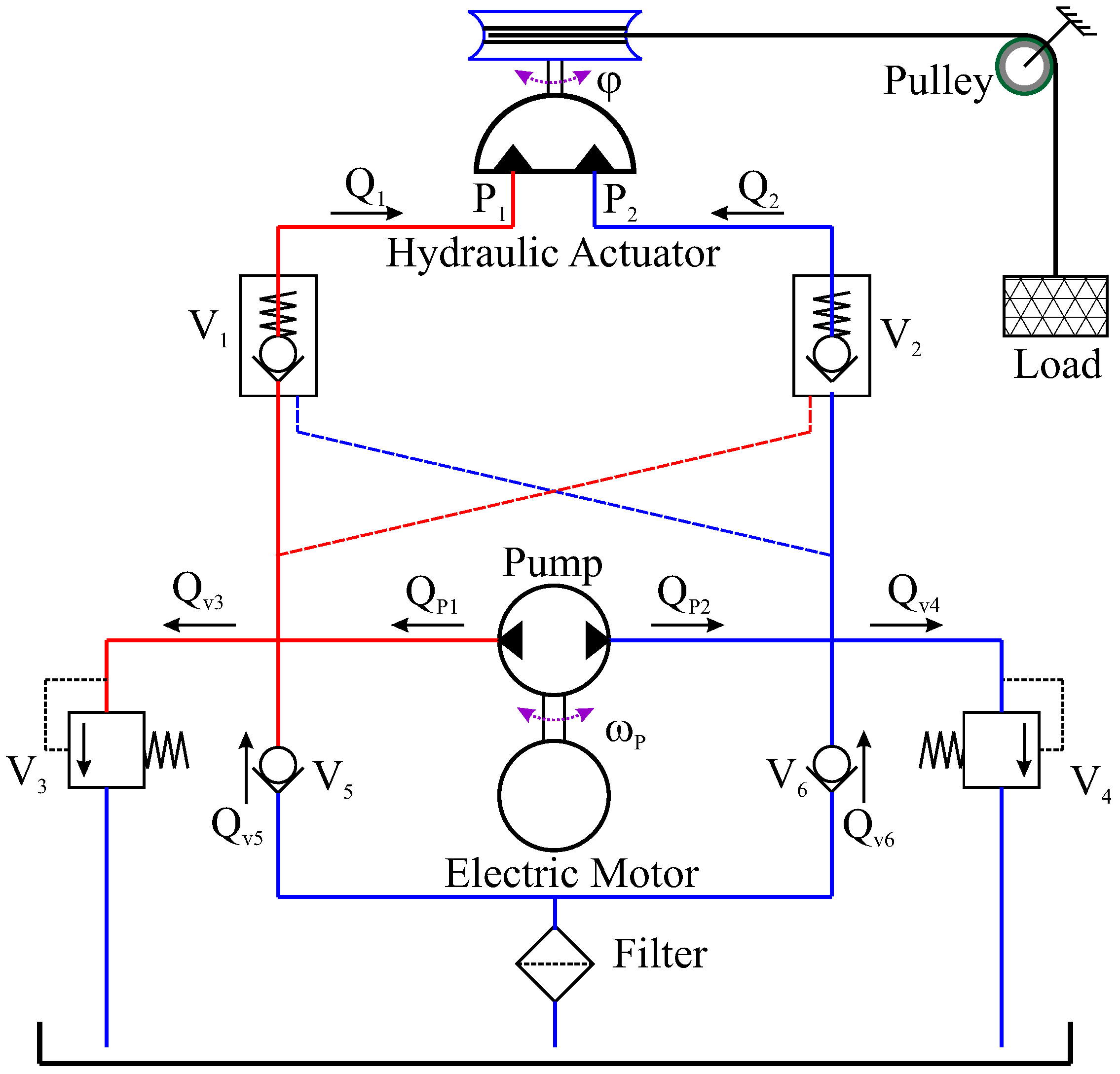


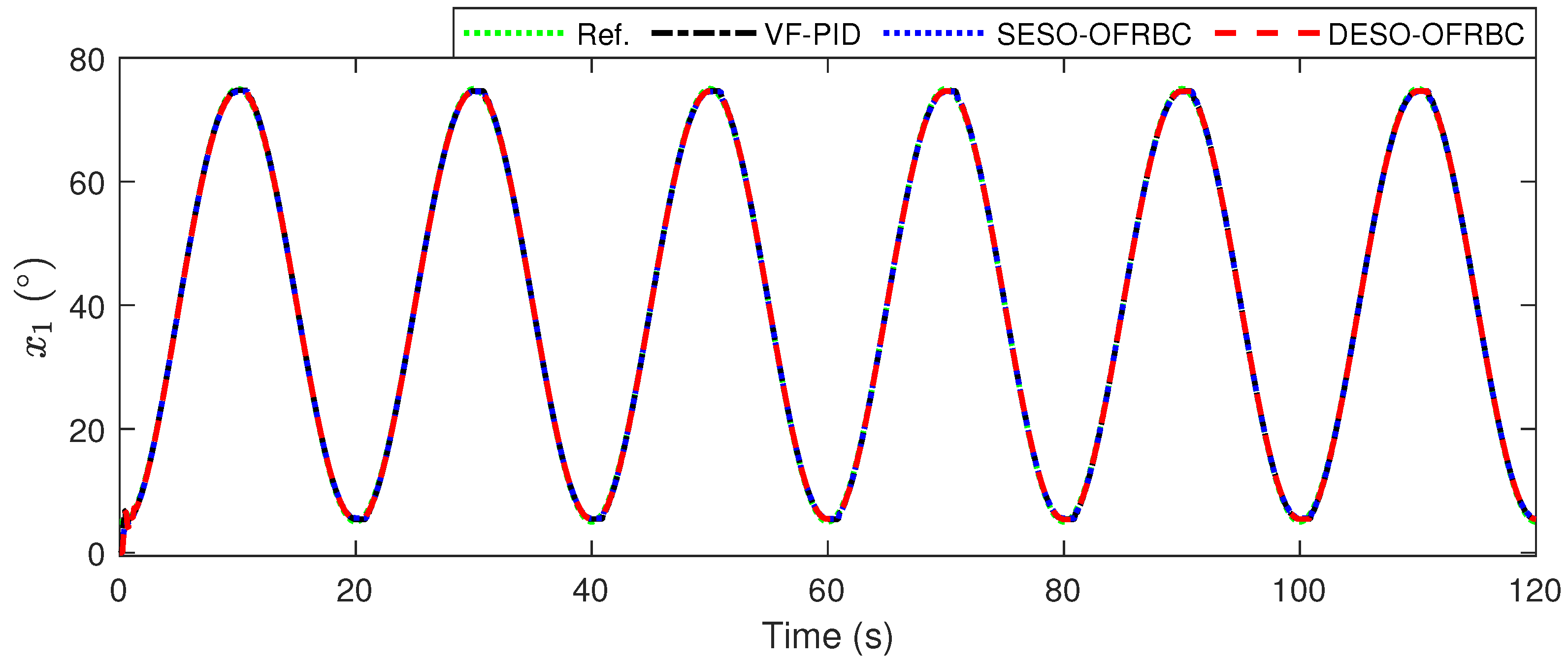

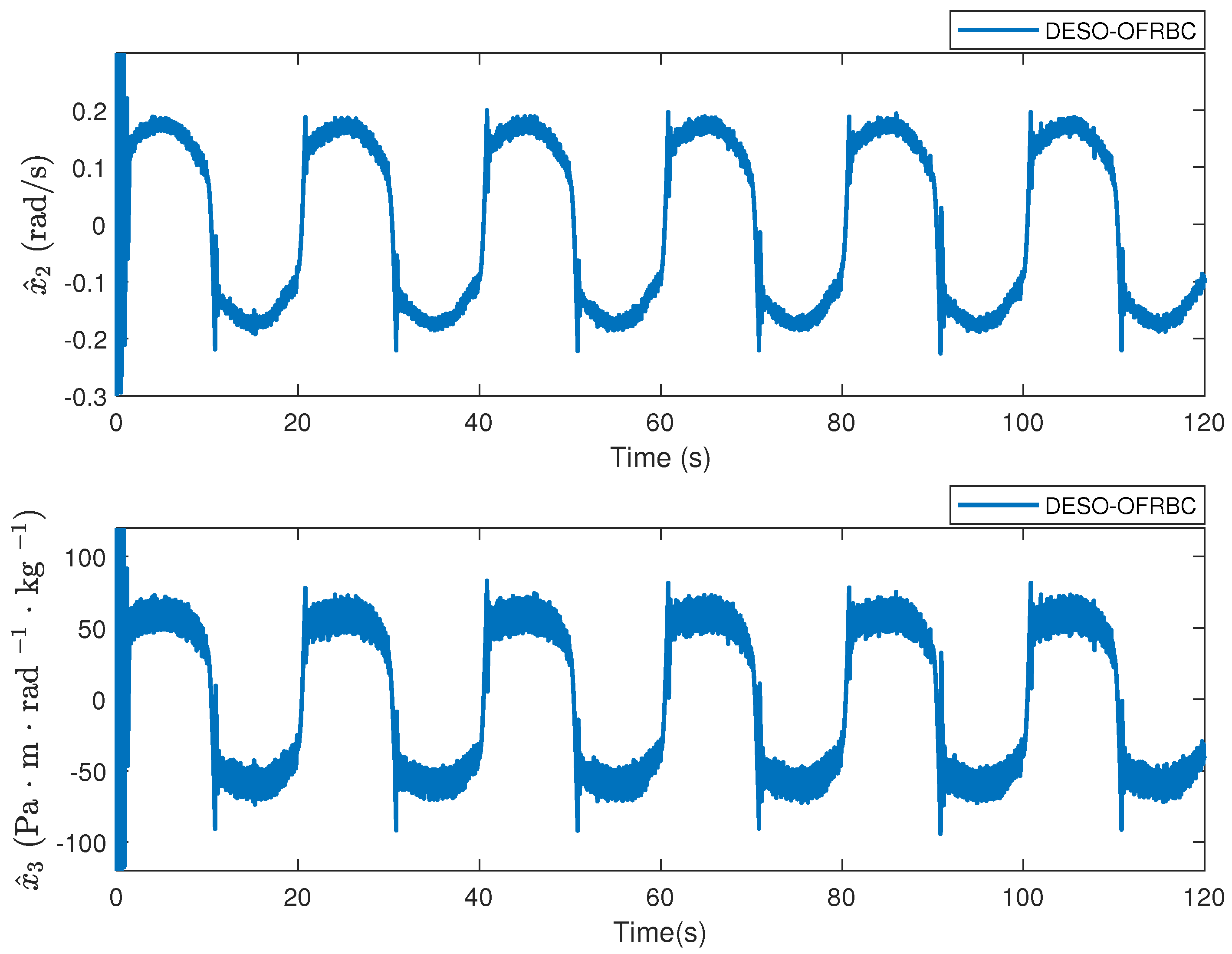
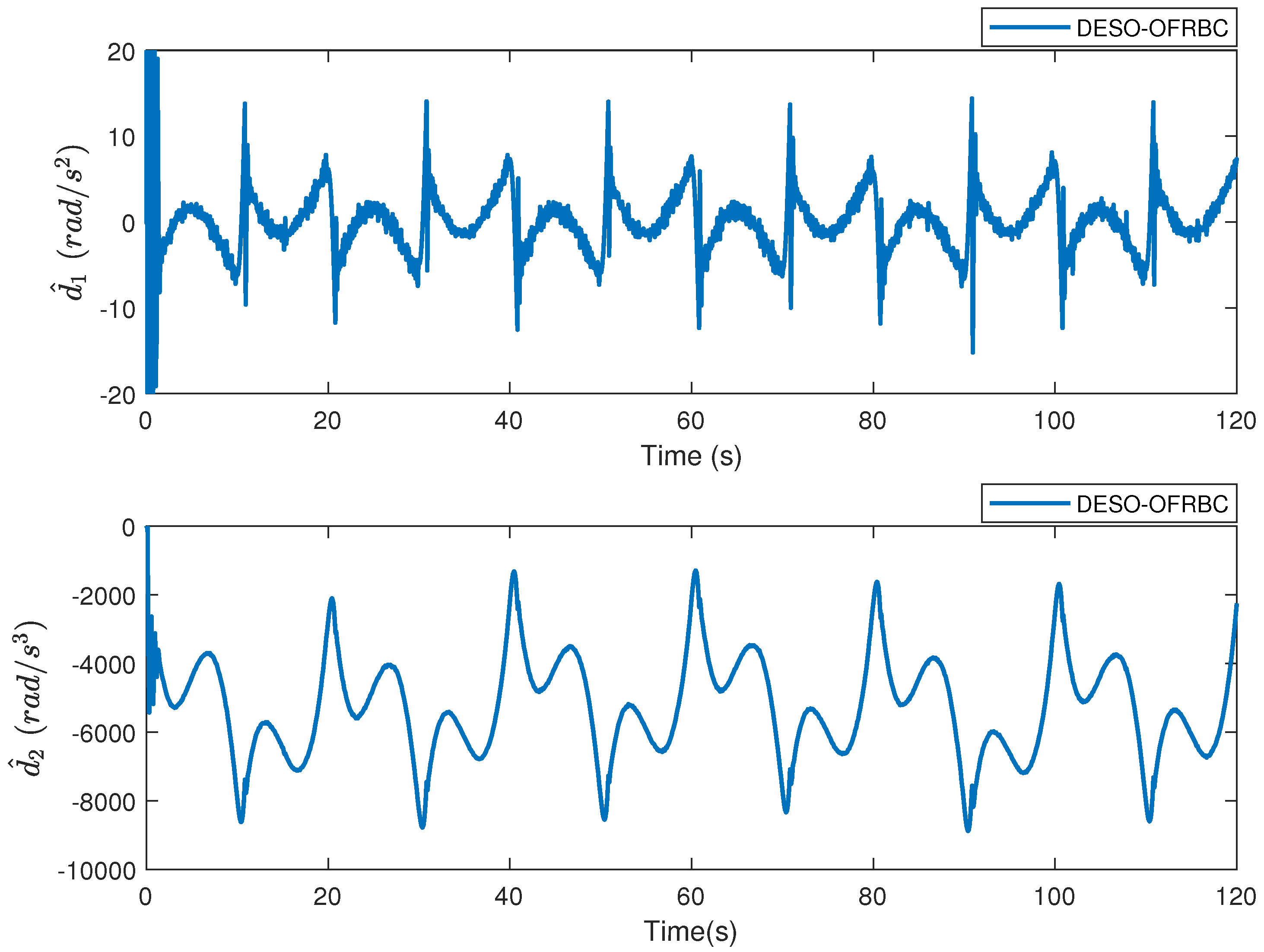
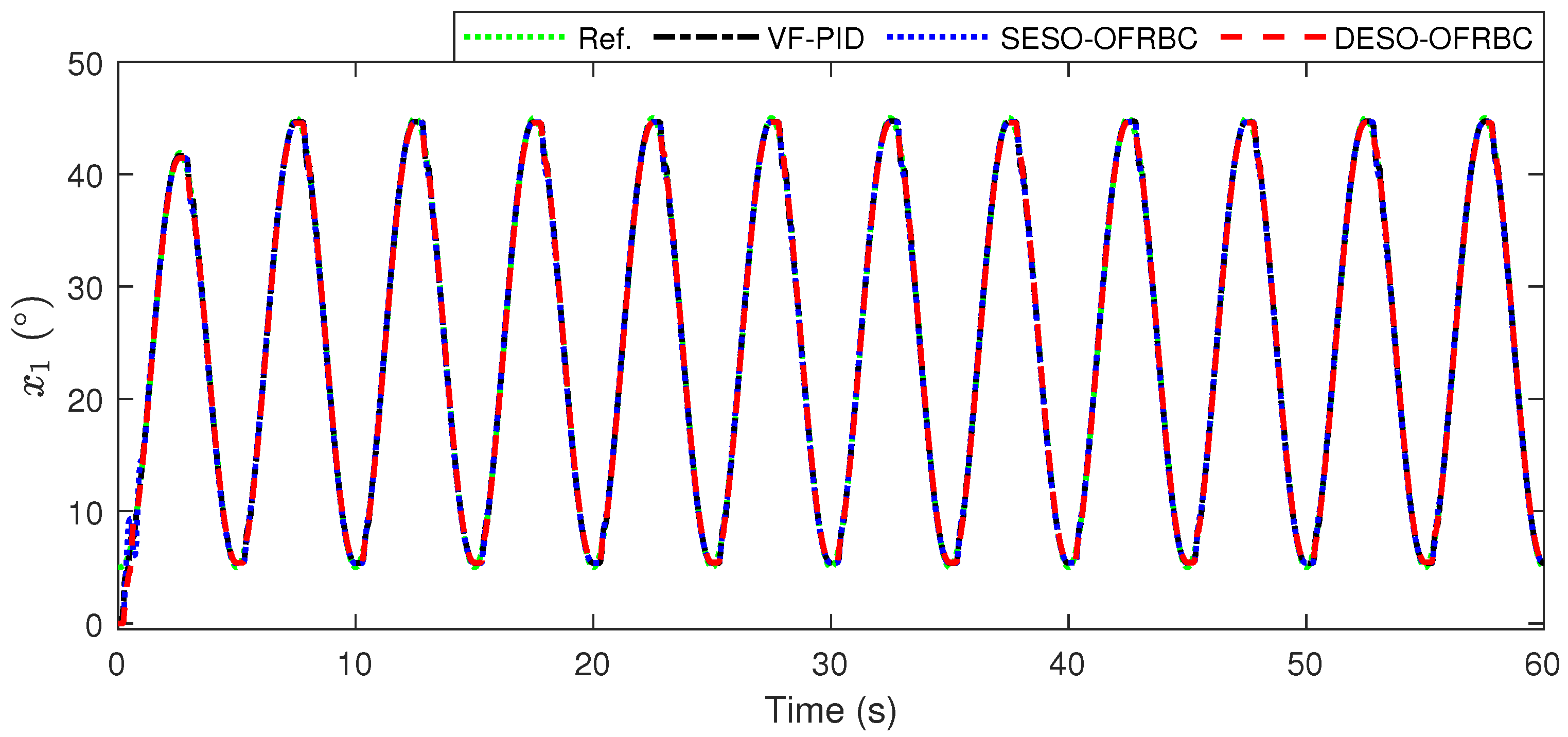
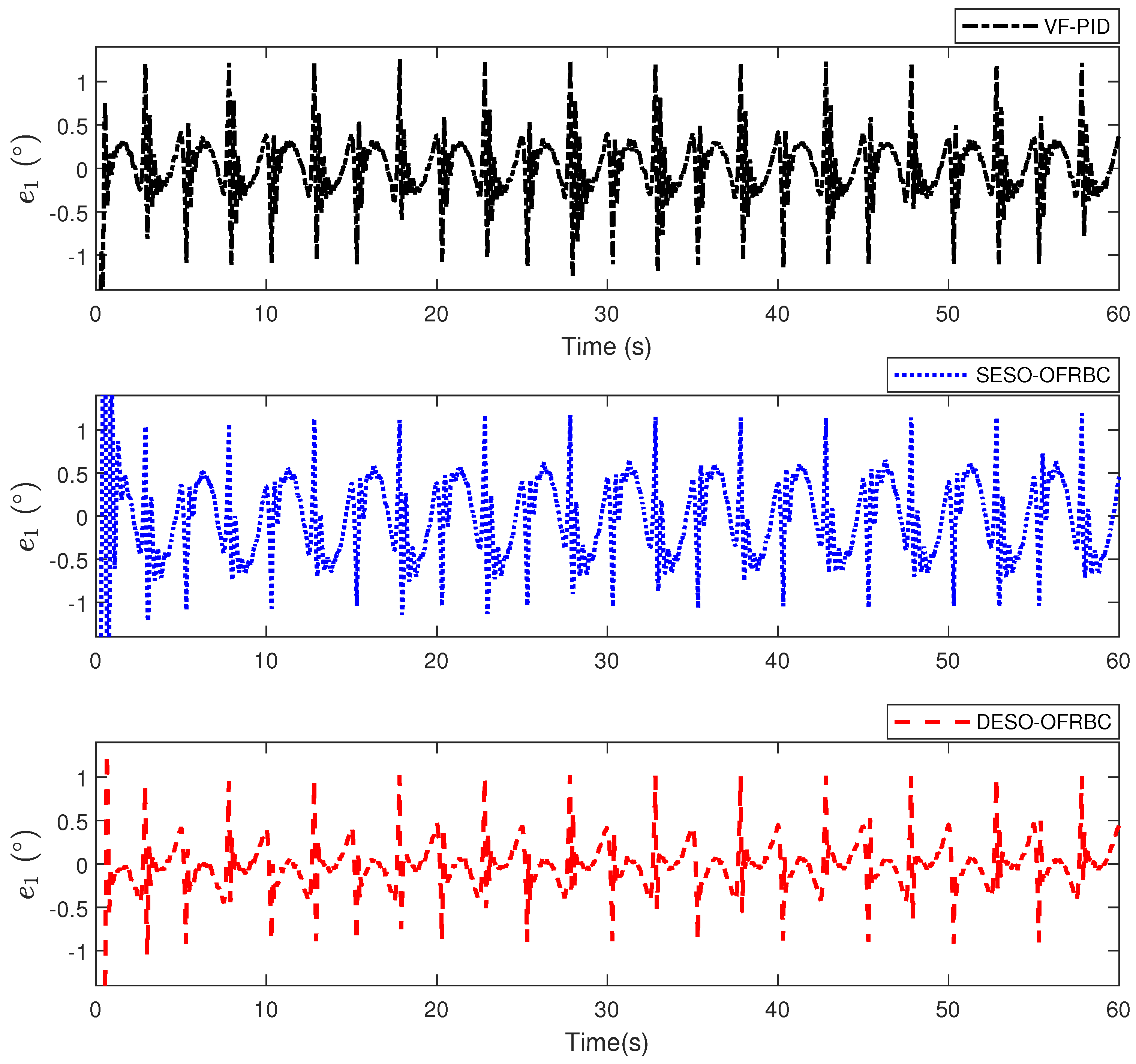
| Parameter | Notation | Value | SI Unit |
|---|---|---|---|
| Viscous friction coefficient of the actuator | 50 | ||
| Coulomb friction coefficient of the actuator | 45 | ||
| Moment of inertia of the actuator | |||
| Hydraulic actuator displacement | |||
| Hydraulic pump displacement | |||
| Effective bulk modulus of the hydraulic oil | |||
| Total leakage coefficient | |||
| Initial control volume of the forward chamber | |||
| Initial control volume of the reverse chamber |
| Controller | (Degree) | (Degree) |
|---|---|---|
| VF-PID Controller | ||
| SESO-OFRBC Controller | ||
| DESO-OFRBC Controller |
| Controller | (Degree) | (Degree) |
|---|---|---|
| VF-PID Controller | ||
| SESO-OFRBC Controller | ||
| DESO-OFRBC Controller |
Disclaimer/Publisher’s Note: The statements, opinions and data contained in all publications are solely those of the individual author(s) and contributor(s) and not of MDPI and/or the editor(s). MDPI and/or the editor(s) disclaim responsibility for any injury to people or property resulting from any ideas, methods, instructions or products referred to in the content. |
© 2023 by the authors. Licensee MDPI, Basel, Switzerland. This article is an open access article distributed under the terms and conditions of the Creative Commons Attribution (CC BY) license (https://creativecommons.org/licenses/by/4.0/).
Share and Cite
Nguyen, M.H.; Ahn, K.K. Output Feedback Robust Tracking Control for a Variable-Speed Pump-Controlled Hydraulic System Subject to Mismatched Uncertainties. Mathematics 2023, 11, 1783. https://doi.org/10.3390/math11081783
Nguyen MH, Ahn KK. Output Feedback Robust Tracking Control for a Variable-Speed Pump-Controlled Hydraulic System Subject to Mismatched Uncertainties. Mathematics. 2023; 11(8):1783. https://doi.org/10.3390/math11081783
Chicago/Turabian StyleNguyen, Manh Hung, and Kyoung Kwan Ahn. 2023. "Output Feedback Robust Tracking Control for a Variable-Speed Pump-Controlled Hydraulic System Subject to Mismatched Uncertainties" Mathematics 11, no. 8: 1783. https://doi.org/10.3390/math11081783
APA StyleNguyen, M. H., & Ahn, K. K. (2023). Output Feedback Robust Tracking Control for a Variable-Speed Pump-Controlled Hydraulic System Subject to Mismatched Uncertainties. Mathematics, 11(8), 1783. https://doi.org/10.3390/math11081783







